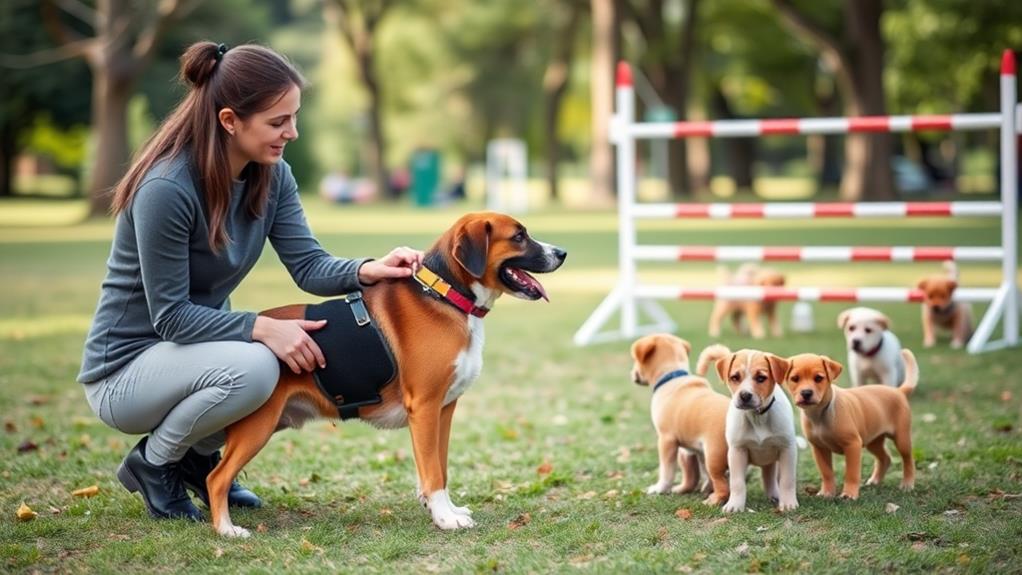To master dog training, start by understanding your dog's behavior and body language. Teach basic commands like "sit" and "stay," using positive reinforcement to reward good behavior. Keep training sessions short—aim for 5-10 minutes—and guarantee everyone uses consistent commands. Set realistic goals and adjust them as your dog progresses. Incorporate play into training to keep things fun and engaging. Patience and persistence are key, as dogs learn at their own pace. If you encounter challenges, seeking professional help can provide valuable insights. There's even more to discover about effective training methods that can benefit both you and your dog.
Understand Your Dog's Behavior
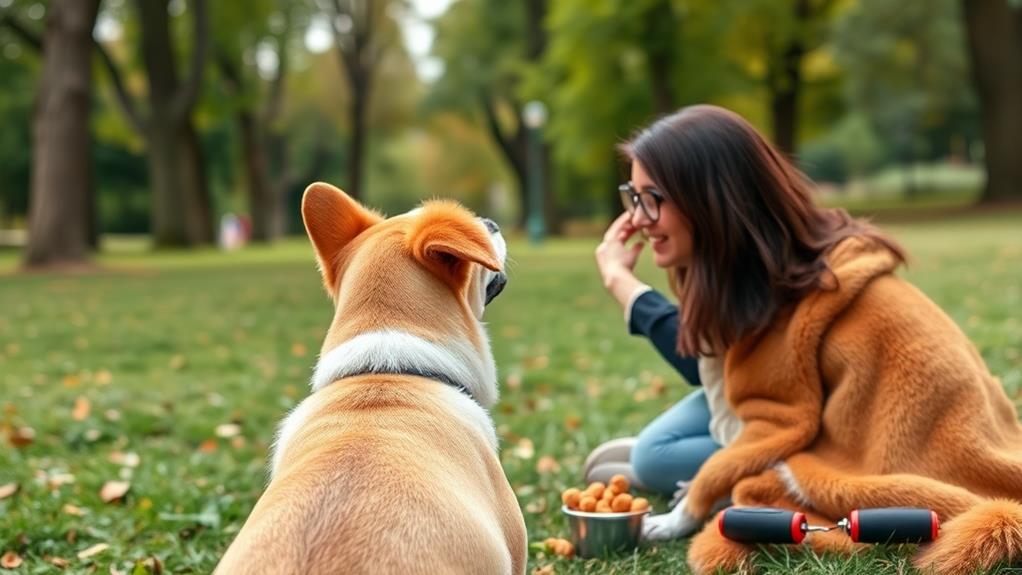
Understanding your dog's behavior is essential for effective training. When you take the time to observe and interpret your dog's actions, you gain insight into their needs, emotions, and motivations. Every bark, wag, and posture communicates something, and recognizing these signals can help you respond appropriately.
Pay attention to your dog's body language. A wagging tail doesn't always mean happiness; it can also indicate excitement or nervousness. Similarly, a lowered head or tucked tail might suggest fear or submission. By understanding these signals, you'll learn when to encourage your dog and when to give them space.
Also, consider the context of their behavior. Are they acting out because they're bored, anxious, or overstimulated? Identifying triggers can help you create a more supportive environment for your dog. For instance, if you notice they become agitated during loud noises, you can work on desensitizing them gradually.
Start With Basic Commands
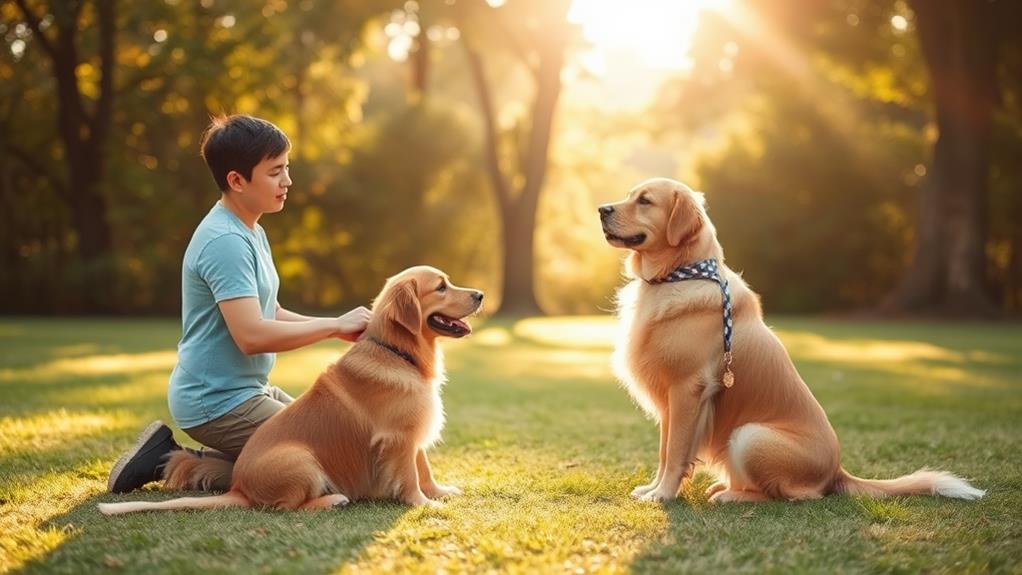
Once you've got a handle on your dog's behavior, it's time to focus on training them with basic commands. Starting with simple commands sets a strong foundation for more advanced training. Here are a few essential commands to teach:
| Command | Purpose | Tips |
|---|---|---|
| Sit | Helps with impulse control | Use treats to guide them |
| Stay | Encourages patience | Gradually increase duration |
| Come | Promotes recall | Practice in a safe area |
| Down | Reduces jumping and excitement | Keep it calm and clear |
Begin each training session in a quiet area with minimal distractions. Use a consistent tone and hand signals for each command. Dogs thrive on routine, so practice regularly to reinforce their learning. Remember to be patient; mastery takes time.
Once your dog knows these basic commands, you'll find it easier to handle various situations. They'll feel more secure with clear expectations, and you'll enjoy a more harmonious relationship. With consistent practice, your dog will respond to commands, making walks and outings more enjoyable for both of you. Happy training!
Use Positive Reinforcement
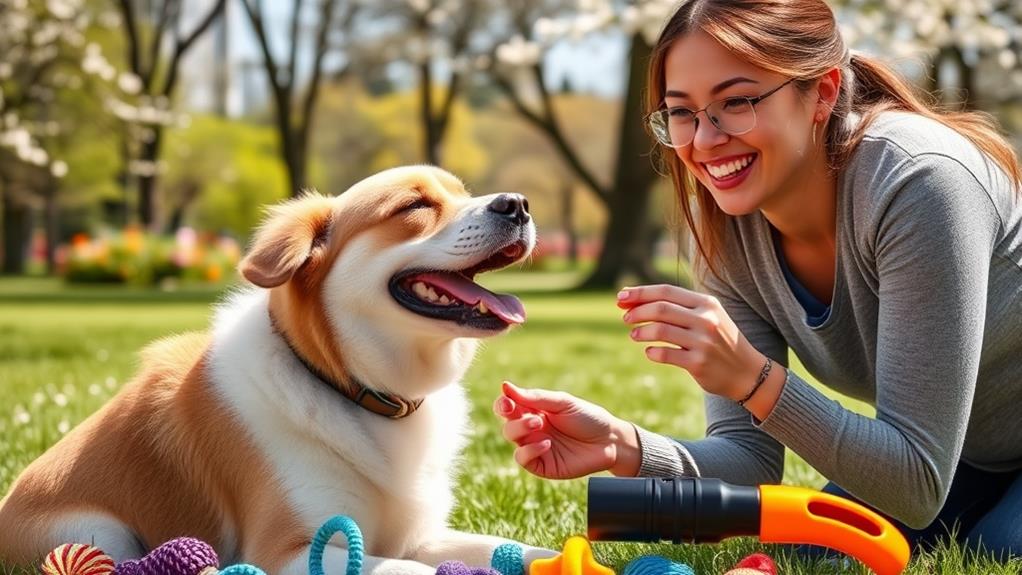
Positive reinforcement is one of the most effective methods for training your dog. By rewarding good behavior, you encourage your pup to repeat those actions. This technique creates a positive association in your dog's mind, making learning more enjoyable for both of you. When your dog follows a command, like "sit" or "stay," immediately offer praise, treats, or playtime as a reward.
Timing is imperative. You need to reward your dog right after they perform the desired behavior. This helps them connect the action with the reward, reinforcing their understanding. Use high-value treats, especially when teaching new commands or behaviors. Choose something your dog loves, like small pieces of chicken or cheese, to keep their motivation high.
Consistency is also important. Make sure everyone in your household uses the same commands and rewards. This prevents confusion and helps your dog learn faster. Don't forget to vary the rewards over time; sometimes a treat, sometimes praise, and sometimes playtime. This keeps the training fresh and exciting for your dog. By using positive reinforcement, you're building a strong bond that leads to a happy, well-trained companion.
Keep Training Sessions Short
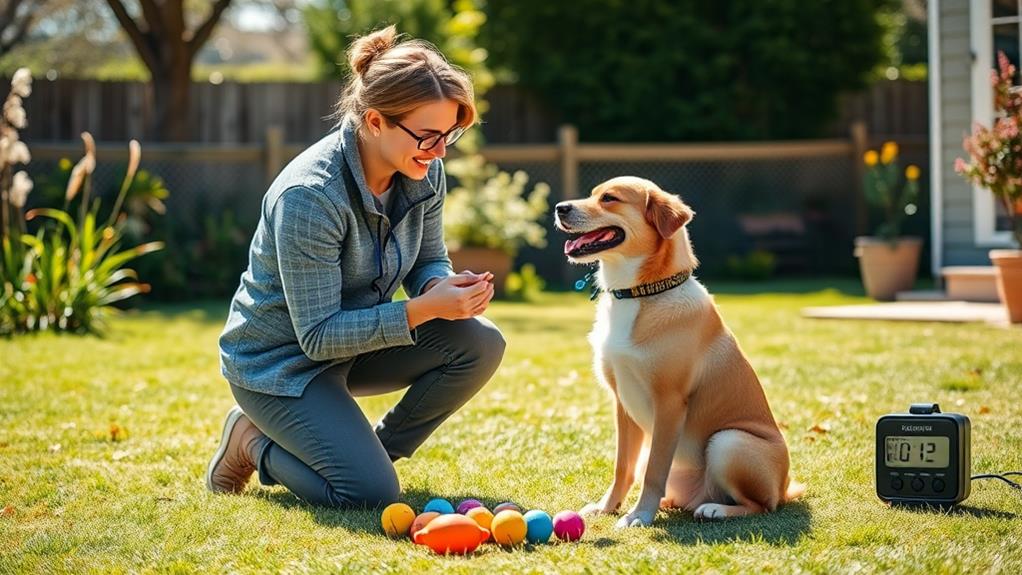
Training sessions should be brief and focused to keep your dog engaged and enthusiastic to learn. Aim for sessions that last no longer than five to ten minutes. This time frame helps maintain your dog's attention and prevents frustration for both of you. If your dog starts to lose interest, it's better to end on a positive note rather than pushing through a longer session that may lead to boredom or confusion.
You can always have multiple short sessions throughout the day, which can be more effective than one long training period. Incorporate training into daily routines, like during walks or playtime, to seamlessly integrate learning into your dog's life.
Make sure to choose a quiet space free from distractions, and focus on one command or trick at a time. This clarity helps your dog understand what you expect from them.
Be Consistent With Commands
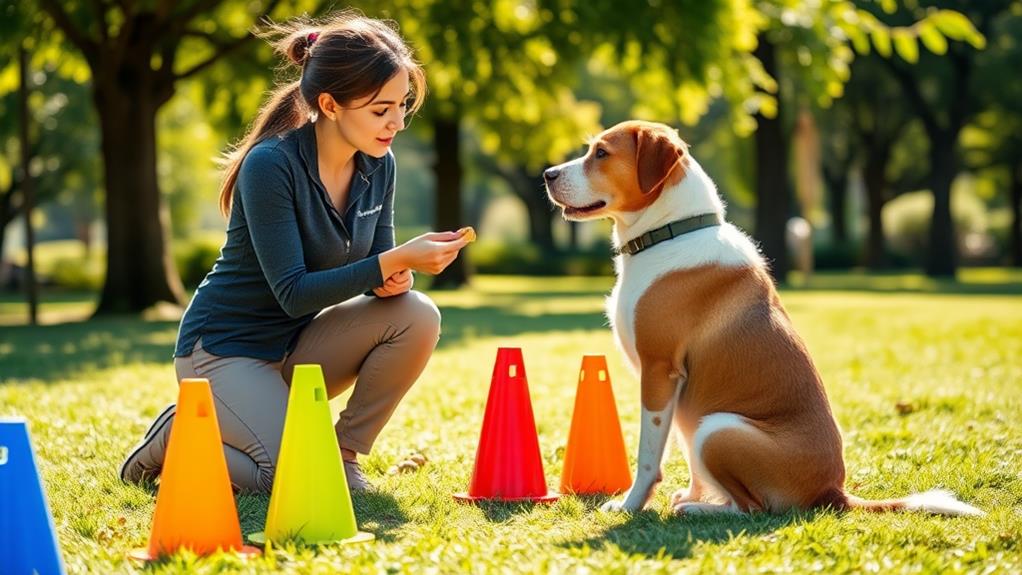
Keeping your training sessions short is just the first step; being consistent with commands is equally important. When you use the same word or phrase for a command every time, your dog will start to understand what you expect. If you switch things up, it can confuse them, making training more challenging.
Here's a helpful guide to guarantee you're consistent:
| Command | Example Phrase |
|---|---|
| Sit | "Sit" |
| Stay | "Stay" |
| Come | "Come" |
| Down | "Down" |
| Heel | "Heel" |
Make sure everyone in your household uses the same commands as well. Consistency isn't just about your words; it's also about your tone and body language. If you say "Sit" in an encouraging tone one time and in a stern tone another, it can confuse your dog. Practice the same commands and signals daily, and be patient. Before long, your dog will respond reliably to your cues, making your training sessions more effective and enjoyable. Remember, consistency is key!
Socialize Your Dog Early
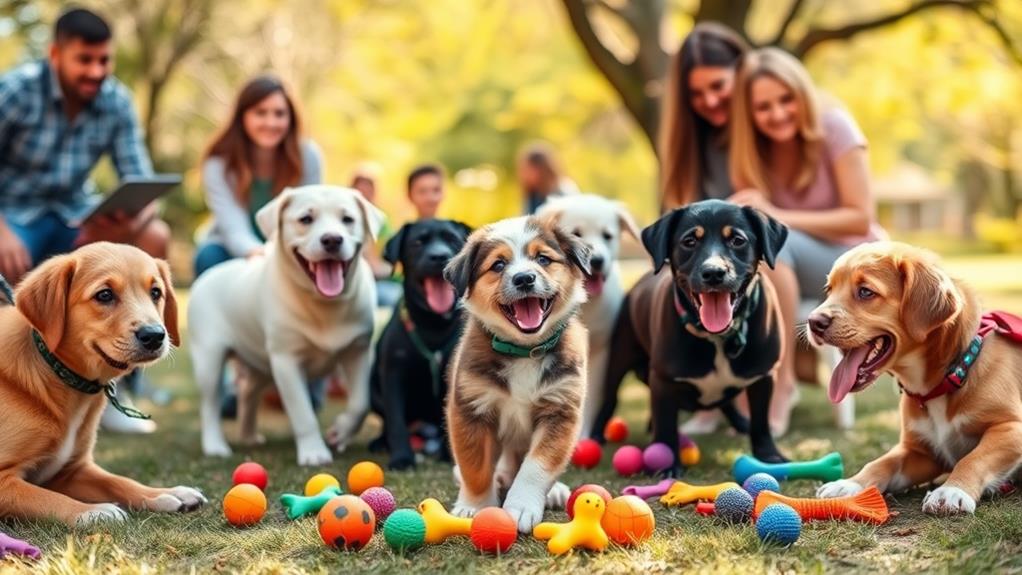
Socialization is essential for your dog's development and well-being. The earlier you start socializing your pup, the better they'll adapt to new experiences, people, and environments. Proper socialization helps prevent behavioral issues later on, making your dog more confident and well-adjusted.
Expose your dog to various environments: Take them to parks, busy streets, and pet-friendly stores. Different sights and sounds will help them learn to cope with new situations.
Introduce your dog to other dogs and people: Arrange playdates with friendly dogs and encourage interactions with various people. This will teach your dog how to behave around others.
Enroll in puppy classes: These classes provide structured socialization opportunities while also teaching basic obedience. You'll gain valuable skills and your dog will have fun!
Set Realistic Goals
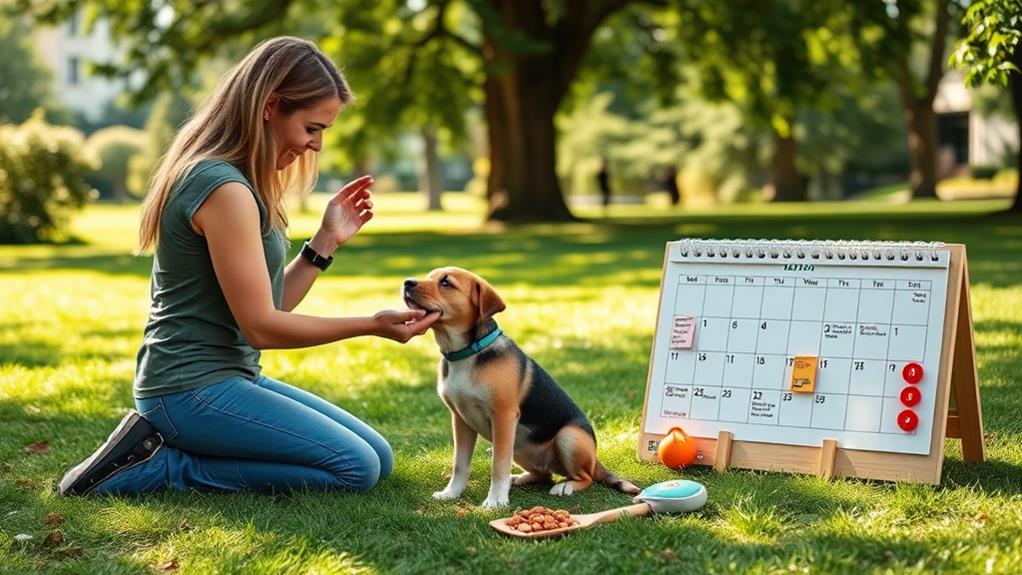
Once your dog has had the chance to socialize with different people and environments, it's important to set realistic goals for their training.
Start by identifying specific behaviors you want to teach, like sit, stay, or come. Break these goals down into achievable steps. For example, instead of expecting your dog to master "stay" immediately, focus on getting them to hold the position for just a few seconds at first.
Consider your dog's age, breed, and personality when setting these goals. Puppies may need more time to learn basic commands, while older dogs might pick up things faster. Be patient and understand that every dog learns at their own pace.
Track your progress and celebrate small victories. If your dog successfully sits on command after a week, that's a win! Adjust your goals as needed based on how your dog responds.
Incorporate Play Into Training
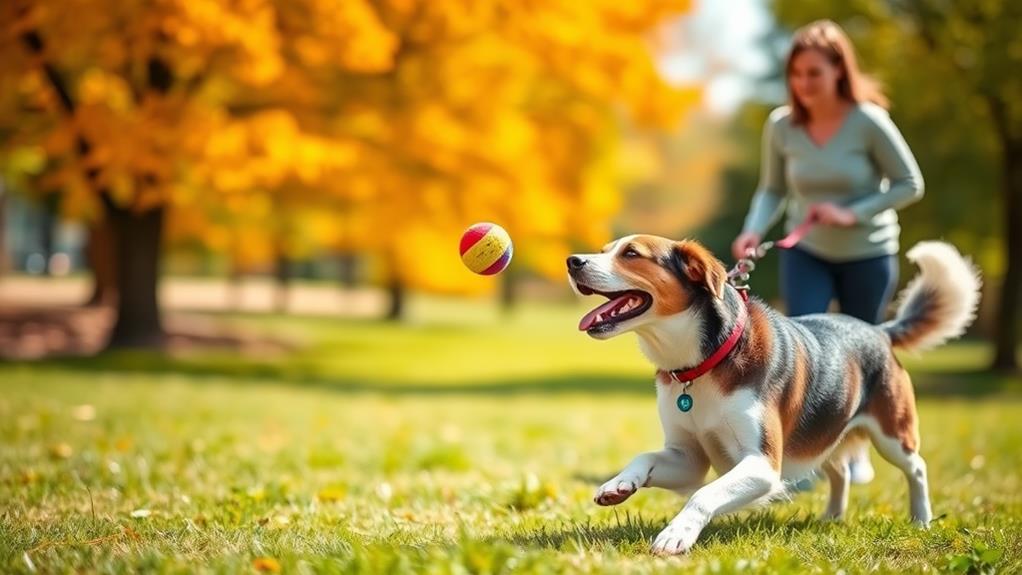
Play is a powerful tool in dog training that can make learning fun and effective. By incorporating play, you not only keep your dog engaged but also strengthen your bond. Dogs thrive on interaction, and when you turn training into a game, they're more likely to embrace the learning process.
Use Toys as Rewards: Instead of just treats, use your dog's favorite toys to reward good behavior. This adds excitement and keeps them motivated.
Incorporate Fetch or Tug: Use games like fetch or tug-of-war to teach commands. For instance, ask your dog to "sit" before throwing a toy, making them understand that obeying commands leads to playtime.
Short, Fun Sessions: Keep training sessions short and playful. A quick 5-10 minute session filled with games will hold their attention better than a longer, more serious one.
Be Patient and Persistent
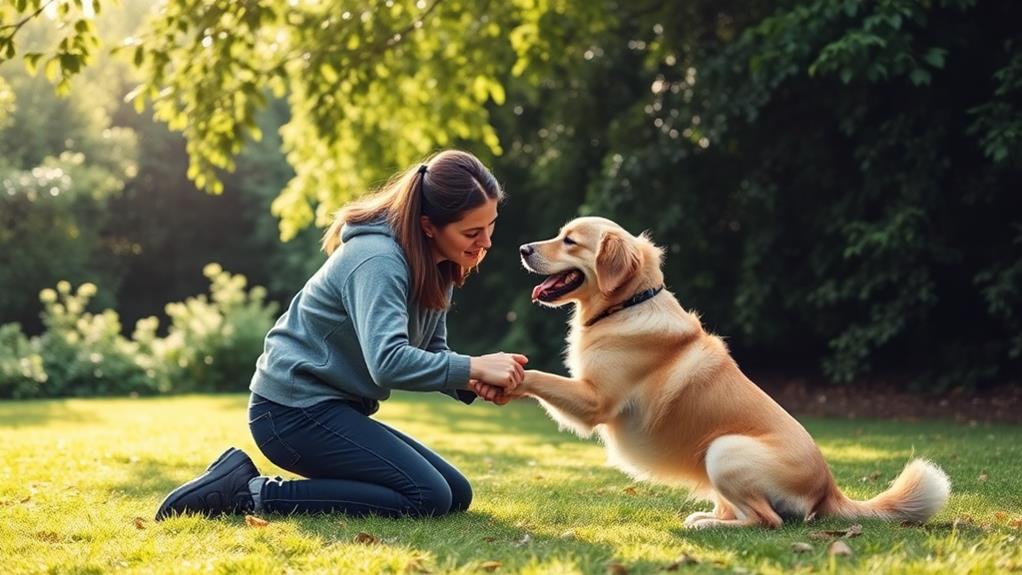
Patience and persistence are crucial elements in successful dog training. You'll face challenges, but staying committed and calm is essential for your dog's learning process. Remember, every dog learns at their own pace, and what works for one may not work for another. Celebrate small victories and don't get discouraged by setbacks.
Tip | Action | Outcome
——————–|———————–|————————
Take Breaks | Schedule short sessions| Prevent frustration
Stay Consistent | Use the same commands | Reinforce learning
Celebrate Progress | Reward small wins | Build confidence
When you find yourself feeling frustrated, take a deep breath. Remind yourself that building a strong bond with your dog takes time. If you stay patient and persistent, you'll see improvements in their behavior and understanding. Trust the process, and you'll foster a loving and obedient companion. Keep your focus on the journey, and don't forget to enjoy the moments you share with your furry friend along the way!
Seek Professional Help if Needed
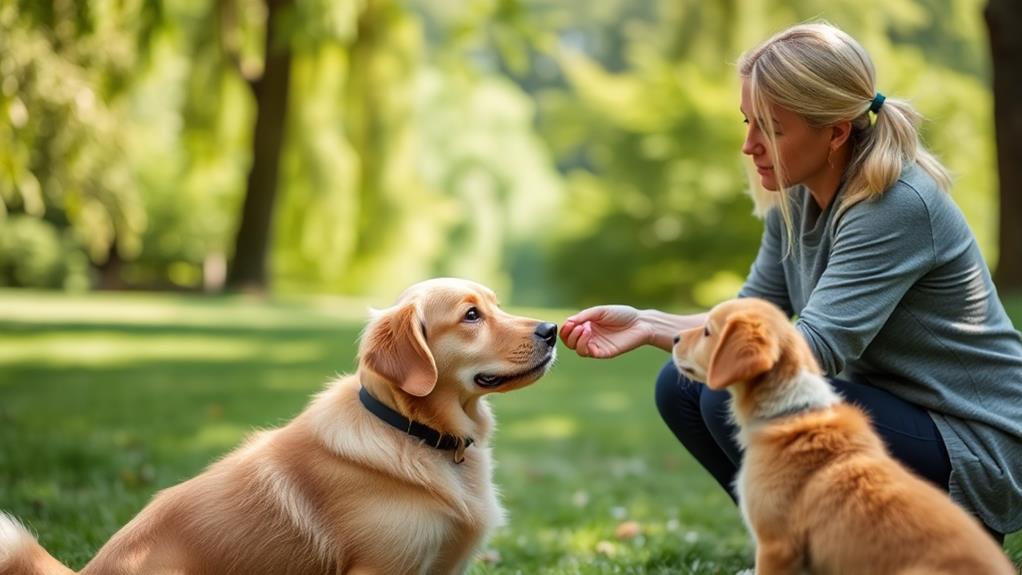
When you're struggling with training your dog, seeking professional help can make all the difference. A skilled trainer can offer personalized guidance, helping you address specific issues and build a stronger bond with your furry friend. Don't hesitate to reach out for assistance; it can save you time, frustration, and even keep your dog safe.
Expertise in Behavior: Trainers understand canine behavior and can identify underlying issues that you might overlook.
Structured Learning: They provide a structured approach, ensuring you and your dog learn effectively and efficiently.
Supportive Environment: Working with a professional offers a supportive space where both you and your dog can thrive.
Frequently Asked Questions
What Age Is Best to Start Training My Dog?
You should start training your dog as early as eight weeks old. This is when they're most receptive to learning. Consistency and positive reinforcement will help them develop good behaviors that'll last a lifetime.
How Do I Correct Bad Behaviors During Training?
Correcting bad behaviors during training's like untangling a knot—requires patience. You'll want to stay consistent, redirect attention to desired actions, and reward good behavior. With time and practice, your dog'll learn what's expected.
Can I Train My Dog Without Treats?
Yes, you can train your dog without treats. Focus on praise, toys, or playtime as rewards. Consistency and positive reinforcement are key; your enthusiasm will motivate your dog just as much as treats would.
How Long Will It Take to See Results?
You'll usually start noticing results within a few weeks, but it depends on your dog's temperament and consistency in training. Stay patient and keep practicing; progress can vary but will come with dedication.
What Should I Do if My Dog Refuses to Listen?
If your dog refuses to listen, try changing your approach. Use positive reinforcement, keep commands simple, and guarantee you're in a distraction-free environment. Consistency and patience will help build better communication between you and your dog.
Conclusion
By applying these tips, you'll be well on your way to mastering dog training. Remember, "patience is a virtue." Each dog learns at their own pace, so stay committed and celebrate the small victories along the way. Whether it's a wagging tail or a successful command, every step forward counts. Enjoy the journey with your furry friend, and don't hesitate to seek professional help if you need it. Together, you can build a strong bond based on trust and understanding.

